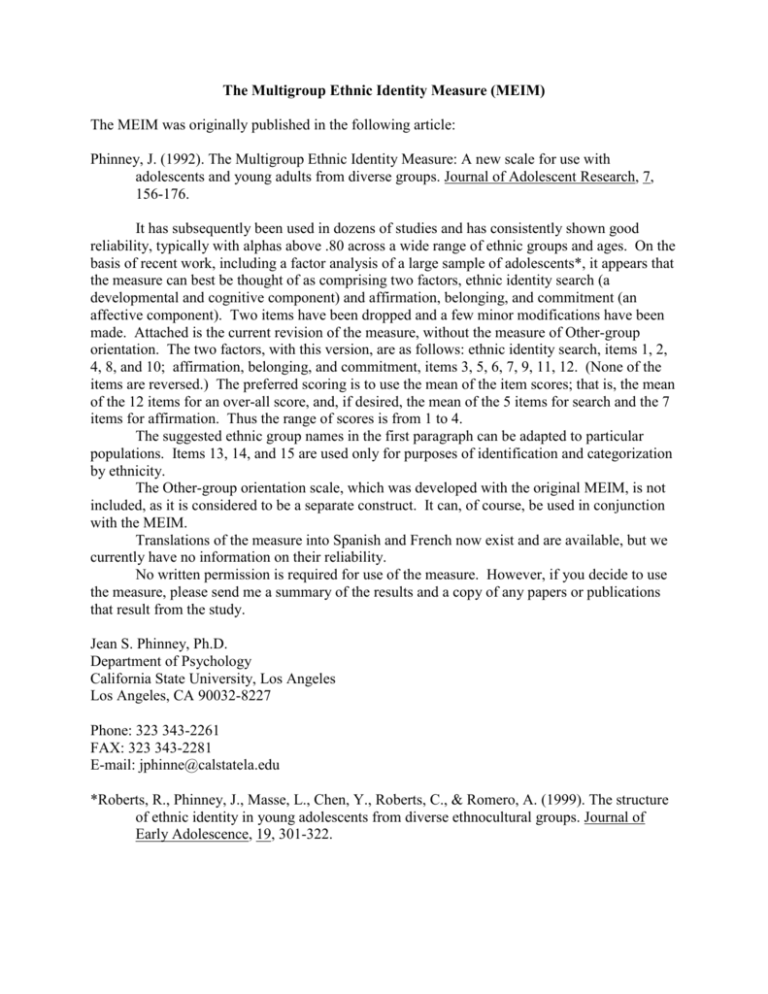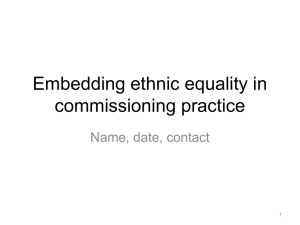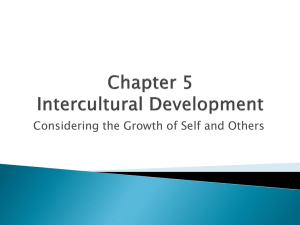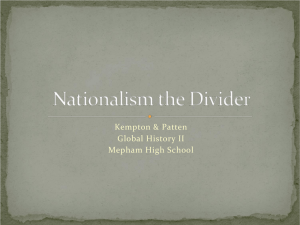The Multigroup Ethnic Identity Measure (MEIM)
advertisement

The Multigroup Ethnic Identity Measure (MEIM) The MEIM was originally published in the following article: Phinney, J. (1992). The Multigroup Ethnic Identity Measure: A new scale for use with adolescents and young adults from diverse groups. Journal of Adolescent Research, 7, 156-176. It has subsequently been used in dozens of studies and has consistently shown good reliability, typically with alphas above .80 across a wide range of ethnic groups and ages. On the basis of recent work, including a factor analysis of a large sample of adolescents*, it appears that the measure can best be thought of as comprising two factors, ethnic identity search (a developmental and cognitive component) and affirmation, belonging, and commitment (an affective component). Two items have been dropped and a few minor modifications have been made. Attached is the current revision of the measure, without the measure of Other-group orientation. The two factors, with this version, are as follows: ethnic identity search, items 1, 2, 4, 8, and 10; affirmation, belonging, and commitment, items 3, 5, 6, 7, 9, 11, 12. (None of the items are reversed.) The preferred scoring is to use the mean of the item scores; that is, the mean of the 12 items for an over-all score, and, if desired, the mean of the 5 items for search and the 7 items for affirmation. Thus the range of scores is from 1 to 4. The suggested ethnic group names in the first paragraph can be adapted to particular populations. Items 13, 14, and 15 are used only for purposes of identification and categorization by ethnicity. The Other-group orientation scale, which was developed with the original MEIM, is not included, as it is considered to be a separate construct. It can, of course, be used in conjunction with the MEIM. Translations of the measure into Spanish and French now exist and are available, but we currently have no information on their reliability. No written permission is required for use of the measure. However, if you decide to use the measure, please send me a summary of the results and a copy of any papers or publications that result from the study. Jean S. Phinney, Ph.D. Department of Psychology California State University, Los Angeles Los Angeles, CA 90032-8227 Phone: 323 343-2261 FAX: 323 343-2281 E-mail: jphinne@calstatela.edu *Roberts, R., Phinney, J., Masse, L., Chen, Y., Roberts, C., & Romero, A. (1999). The structure of ethnic identity in young adolescents from diverse ethnocultural groups. Journal of Early Adolescence, 19, 301-322. In this country, people come from many different countries and cultures, and there are many different words to describe the different backgrounds or ethnic groups that people come from. Some examples of the names of ethnic groups are Hispanic or Latino, Black or African American, Asian American, Chinese, Filipino, American Indian, Mexican American, Caucasian or White, Italian American, and many others. These questions are about your ethnicity or your ethnic group and how you feel about it or react to it. Please fill in: In terms of ethnic group, I consider myself to be ____________________ Use the numbers below to indicate how much you agree or disagree with each statement. (4) Strongly agree (3) Agree (2) Disagree (1) Strongly disagree 1- I have spent time trying to find out more about my ethnic group, such as its history, traditions, and customs. 2- I am active in organizations or social groups that include mostly members of my own ethnic group. 3- I have a clear sense of my ethnic background and what it means for me. 4- I think a lot about how my life will be affected by my ethnic group membership. 5- I am happy that I am a member of the group I belong to. 6- I have a strong sense of belonging to my own ethnic group. 7- I understand pretty well what my ethnic group membership means to me. 8- In order to learn more about my ethnic background, I have often talked to other people about my ethnic group. 9- I have a lot of pride in my ethnic group. 10- I participate in cultural practices of my own group, such as special food, music, or customs. 11- I feel a strong attachment towards my own ethnic group. 12- I feel good about my cultural or ethnic background. 13- My ethnicity is (1) Asian or Asian American, including Chinese, Japanese, and others (2) Black or African American (3) Hispanic or Latino, including Mexican American, Central American, and others (4) White, Caucasian, Anglo, European American; not Hispanic (5) American Indian/Native American (6) Mixed; Parents are from two different groups (7) Other (write in): _____________________________________ 14- My father's ethnicity is (use numbers above) 15- My mother's ethnicity is (use numbers above)








